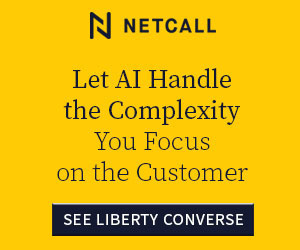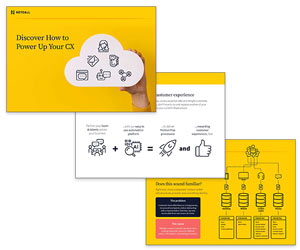Chris Martin at Netcall delves deeper into what agentic AI truly involves and looks at what this technology really means for your organisation.
Understanding Agentic AI
Agentic AI refers to systems capable of autonomous decision-making and task execution without constant human oversight. Think of it as an efficient expert working on your task (that never sleeps).
Unlike traditional automation, which follows predefined rules, agentic AI adapts to dynamic environments, learning and evolving over time.
It can make decisions, adapt on the fly and handle curveballs, working through the more automatable tasks in the background and only bringing you in when you are needed.
This capability to learn from experience and improve over time allows for more nuanced and efficient handling of complex tasks.
The Allure and Misconceptions
Everyone’s jumping on the AI bandwagon and the rapid advancement of agentic AI has led to a surge in its adoption claims. But not all claims are created equal.
Many organisations tout agentic capabilities, yet often these are limited to basic automation or scripted responses. True agentic AI involves a higher level of autonomy and adaptability, characteristics that are not easily achieved.
It’s like the difference between a GPS that just gives directions versus one that reroutes you around traffic, suggests better routes based on your driving habits and learns your preferences over time.
Why Agentic AI?
The value of agentic AI lies in its ability to enhance workflows with flexibility and responsiveness. This is when the magic happens, when your systems become genuinely responsive rather than just reactive.
Unlike rigid rule-based systems, agentic AI can interpret natural language, make context-aware decisions and access a wide range of predefined tools.
Imagine workflows that understand context, interpret what people actually mean (not literal explanations) and tap into your existing tools seamlessly.
Agentic AI in Action: Practical Illustrations
Let’s look at some scenarios across various sectors, which illustrate how AI agents autonomously select and execute functions, streamlining complex workflows and enhancing efficiency.
Healthcare: Streamlined Patient Discharge Coordination
Scenario: A hospital aims to optimise patient discharge processes to reduce bed occupancy rates.
Agentic AI Workflow:
1. Function selection: The AI agent accesses functions to:
- Review patient medical records
- Check availability of community care services
- Schedule follow-up appointments
- Arrange transportation.
2. Execution: The AI agent autonomously:
- Identifies patients ready for discharge
- Coordinates with community services for continued care
- Books necessary appointments and transportation.
3. Human-in-the-loop:
Healthcare staff are notified to review and approve the discharge plan before finalisation.
Benefit: This enhances efficiency in patient discharges, freeing up hospital beds and ensuring continuity of care.
Local Government: Automated Permit Processing
Scenario: A local council needs to speed up building permit approvals.
Agentic AI Workflow:
1. Function selection: The AI agent utilises functions to:
- Validate application completeness
- Cross-reference zoning regulations
- Assess environmental impact
- Schedule inspections.
2. Execution: The AI agent processes applications by:
- Ensuring all required documents are submitted
- Verifying compliance with local regulations
- Coordinating inspection schedules.
3. Human-in-the-loop:
Planning officers receive summarised reports for final approval.
Benefit: This reduces processing time for permits, which improves service delivery to residents and developers.
Finance: Personalised Investment Portfolio Management
Scenario: A bank offers clients tailored investment strategies.
Agentic AI Workflow:
1. Function selection: The AI agent selects functions to:
- Analyse market trends
- Assess client risk profiles
- Rebalance portfolios.
2. Execution: The AI agent:
- Monitors financial markets in real-time
- Adjusts investment portfolios to align with client goals and market conditions.
3. Human-in-the-loop:
Financial advisors are alerted to significant changes and can provide additional insights to clients.
Benefit: This delivers dynamic investment strategies, which enhance customer experience and trust.
Insurance: Efficient Claims Processing
Scenario: An insurance company needs faster claims handling.
Agentic AI Workflow:
1. Function selection: The AI agent accesses functions to:
- Validate claim information
- Detect potential fraud
- Calculate claim payouts.
2. Execution: The AI agent:
- Reviews submitted claims for completeness and accuracy
- Flags suspicious claims for further investigation
- Processes legitimate claims promptly.
3. Human-in-the-loop:
Claims adjusters review flagged cases and oversee high-value claims.
Benefit: This both reduces fraud and accelerates claims processing, improves customer experience.
This blog post has been re-published by kind permission of Netcall – View the Original Article
For more information about Netcall - visit the Netcall Website
Call Centre Helper is not responsible for the content of these guest blog posts. The opinions expressed in this article are those of the author, and do not necessarily reflect those of Call Centre Helper.
Author: Netcall
Reviewed by: Rachael Trickey
Published On: 14th Aug 2025
Read more about - Guest Blogs, Netcall






 Netcall is trusted by organisations worldwide, with 9 out of 10 customers ready to recommend us. With Liberty Converse CX, you can streamline operations, enhance customer engagement, and achieve real, measurable results.
Netcall is trusted by organisations worldwide, with 9 out of 10 customers ready to recommend us. With Liberty Converse CX, you can streamline operations, enhance customer engagement, and achieve real, measurable results. 











